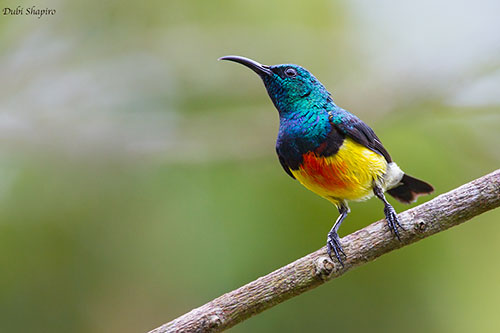
The adult female has grey-brown upperparts with bluish-black tail and browner wings, but the wing-coverts are dark grey.
On the underparts, chin and throat to breast are pale grey with weak darker grey streaks. Rest of underparts is yellow with brighter centre of belly. The vent is whitish. Lower flanks and undertail-coverts are pale greyish. On the underwing, the axillaries are yellow.
The juvenile has grey-brown upperparts with darker flight-feathers. The underparts are yellowish. Legs and feet are flesh-coloured.
RANGE:
The Mayotte Sunbird is found on Mayotte Island and some nearby islets, in the SE of Comoros Archipelago.
HABITAT:
The Mayotte Sunbird usually avoids the dense forest, and frequents mainly open areas and forest edge. The species occurs from sea-level to 460 metres of elevation.
CALLS AND SONGS: SOUNDS BY XENO-CANTO
The Mayotte Sunbird gives harsh, mewing “cheer” repeated or interspersed within song phrases. We can also hear a nasal “chit” rapidly repeated.
The song includes various fluted rapid notes, sometimes preceded by soft “pi” notes.
BEHAVIOUR IN THE WILD:
The Mayotte Sunbird feeds on various insect species, pupae of Cicadidae, and small caterpillars. It also takes spiders, and probably feeds on nectar too.
It is known to feed in Baobab and Papaya trees. It also forages among the leaves of coconut palms and can be observed near Acacia and Mimosa species.
Numerous species, including those of the genus Cinnyris, catch insects by hawking and sallying for prey.
Most sunbird species are territorial during the breeding season. The males defend territories by singing from exposed perches, often at treetops. They may show aggressive behaviour towards intruders. During these actions, the bright colours of the plumage are enhanced by adapted postures.
The Mayotte Sunbird is probably monogamous. The copulation follows the male’s displays, during which it exposes the yellow feathers of the pectoral tufts. Some chases between mates probably occur too.
The Mayotte Sunbird is apparently sedentary and only moves over short distances, depending on food availability.
REPRODUCTION OF THIS SPECIES:
The breeding season starts apparently in October/November.
The hanging nest is built by the female. It is described as an oval purse-shaped structure made with woven grass. There is a small porch above the entrance placed towards the top of the nest. We can see some strands of grass trailing below the bottom of the nest. A thick lining is made inside with plant fibres. The nest is about three metres above the ground.
The clutch size is unknown, and information about this behaviour is currently lacking.
PROTECTION / THREATS / STATUS:
The Mayotte Sunbird has restricted range in which it is common. The population is apparently stable and the species is not globally threatened.
The Mayotte Sunbird is currently evaluated as Least Concern.
Fr: Souimanga de Mayotte
Ang: Mayotte Sunbird
All: Mayottenektarvogel
Esp: Suimanga de Mayotte
Ita: Nettarinia di Mayotte
Nd: Mayottehoningzuiger
Sd: mayottesolfågel
Photographer:
Dubi Shapiro
Dubi Shapiro Photo Galleries & Dubi Shapiro's Pictures on IBC
Text by Nicole Bouglouan
Sources:
HANDBOOK OF THE BIRDS OF THE WORLD Vol 13 by Josep del Hoyo-Andrew Elliot-Jordi Sargatal - Lynx Edicions – ISBN: 9788496553453
SUNBIRDS by Roberts A. Cheke, Clive F. Mann and Richard Allen Helm, 2001 - ISBN: 1873403801
Birds of the Indian Ocean Islands Par Ian Sinclair, Olivier Langrand - ISBN: 1868729567, 9781868729562- Editeur: Struik, 2003
Home page
Page Order Passeriformes
Mayotte Sunbird
Cinnyris coquerellii
Passeriformes Order – Nectariniidae Family
INTRODUCTION:
The Mayotte Sunbird is endemic to Mayotte Island in the Comoros Archipelago where it can be seen in open areas and at forest edge. It feeds on various insect species and also takes nectar. It nests in a covered structure hanging from a branch, about three metres above the ground.
The Mayotte Sunbird is described as “common” within its restricted range, and the species is not currently threatened.
DESCRIPTION OF THE BIRD:
Biometrics:
Length: 10 cm
Weight: M: 9 g – F: 7 g
The Mayotte Sunbird adult male has head, upperparts, chin, throat to upper breast, and lesser and median coverts glossy dark green. There are some purple iridescence on back and lower rump. Flight-feathers and tail feathers are black with blue gloss. There is a narrow, purple band across the upper breast, whereas centre of breast and belly is orange-red. Rest of underparts is yellow, including the pectoral tufts. The vent is mostly buffy-white.
Bill, legs and feet are black. The eyes are dark brown.
